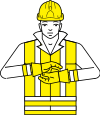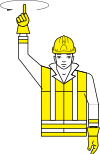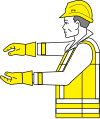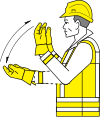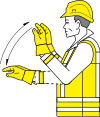| European Union directive | |
 | |
| Title | COUNCIL DIRECTIVE 92/58/EEC of 24 June 1992 on the minimum requirements for the provision of safety and/or health signs at work (ninth individual Directive within the meaning of Article 16 (1) of Directive 89/391/EEC) |
|---|---|
| Made by | Council |
| Journal reference | L 245, 26 August 1992, pp. 23–42 |
| History | |
| Date made | 24 June 1992 |
| Entry into force | 22 July 1992 |
| Other legislation | |
| Replaces | Directive 77/576/EEC |
| Amended by |
|
| Substantially amended | |
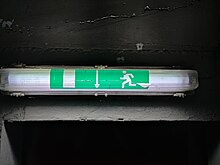
The Directive 92/58/EEC specifies the minimum requirements for safety signs within the European Union. It superseded the Directive 77/576/EEC. While not being replaced by the standard ISO 7010, both signage systems can be used. This directive does not apply to signage used for controlling roadway, railway, waterway or air transportation.
Structure
Directive 92/58/EEC consists of 3 sections, 12 articles and 9 annexes. Section one simply defines the function of the directive, as well as provide definitions. Section 2 specifies that employers are required to post safety/health signs, whenever a hazard can't be eliminated. It also provides guidance to member states regarding adoption of the directive in their laws and the implementation of the law. Signs already in use had to be brought up to Directive 92/58/EEC standards within 18 months after 24 June 1994. Signs posted on or after 24 June 1994 were required to comply with the directive when posted. Section 3 contained the effective date for the directive, repealed the older Directive 77/576, and reporting obligations of member states to the European Commission.
Annexes
The nine annexes of the directive layout the actual designs and requirements of signs regulated by the directive.
Annex I
Annex I, General Minimum Requirements Concerning Safety And/Or Health Signs At Work, lays out the types of signs, the colors used on signs, and the implementation/installation of signs.
| Colour | Purpose | Examples |
|---|---|---|
| Red | Prohibited sign | Restriction of dangerous or undesirable behaviours or objects |
| Danger alarm | Stop, shutdown, evacuate, identification and location of emergency stop switches | |
| Fire-fighting equipment | Identification and location of fire-fighting equipment | |
| Yellow/amber | Warning sign | Identification of hazards |
| Blue | Mandatory sign | requiring a specific behaviour or action, wearing personal protective equipment |
| Green | Emergency escape, first aid sign | location and identification of doors, exits, evacuation routes, equipment and facilities |
| No danger | Return to normal working |
Annex II (Signboards)
Annex II, Minimum General Requirements Concerning Signboards, spells out the designs of symbols used in the directive. While specific symbol designs are provided, pictograms are permitted to vary so long as the variation in design does not reduce the symbol's effectiveness at conveying its meaning.
The directive contains five categories of signs, as shown below:
Prohibitory signs
-
 No smoking
No smoking
-
 Smoking and naked flames forbidden
Smoking and naked flames forbidden
-
 No access for pedestrians
No access for pedestrians
-
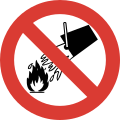 Do not extinguish with water
Do not extinguish with water
-
 Not drinkable
Not drinkable
-
 No access for unauthorized persons
No access for unauthorized persons
-
 No access for industrial trucks
No access for industrial trucks
-
 Do not touch
Do not touch
Warning signs
-
 Flammable material or high temperature
Flammable material or high temperature
-
 Explosive material
Explosive material
-
 Toxic material
Toxic material
-
 Corrosive material
Corrosive material
-
 Radioactive material
Radioactive material
-
 Overhead load
Overhead load
-
 Industrial vehicles
Industrial vehicles
-
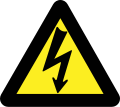 Danger: electricity
Danger: electricity
-
 General danger
General danger
-
 Laser beam
Laser beam
-
 Oxidant material
Oxidant material
-
 Non-ionizing radiation
Non-ionizing radiation
-
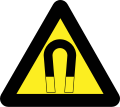 Strong magnetic field
Strong magnetic field
-
 Obstacles
Obstacles
-
 Drop
Drop
-
 Biological risk
Biological risk
-
 Low temperature
Low temperature
-
 Harmful or irritant material
Harmful or irritant material
(Withdrawn 2014)
Mandatory signs
-
 Eye protection must be worn
Eye protection must be worn
-
 Safety helmet must be worn
Safety helmet must be worn
-
 Ear protection must be worn
Ear protection must be worn
-
 Respiratory equipment must be worn
Respiratory equipment must be worn
-
 Safety boots must be worn
Safety boots must be worn
-
 Safety gloves must be worn
Safety gloves must be worn
-
 Safety overalls must be worn
Safety overalls must be worn
-
 Face protection must be worn
Face protection must be worn
-
 Safety harness must be worn
Safety harness must be worn
-
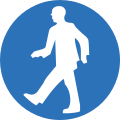 Pedestrians must use this route
Pedestrians must use this route
-
 General mandatory sign (to be accompanied where necessary by another sign)
General mandatory sign (to be accompanied where necessary by another sign)
Emergency escape or first-aid signs
-
 Emergency exit/escape route
Emergency exit/escape route
-
 Emergency exit/escape route
Emergency exit/escape route
-
 Emergency exit/escape route
Emergency exit/escape route
-
 Emergency exit/escape route
Emergency exit/escape route
-
 Emergency exit/escape route
Emergency exit/escape route
-
 This way (supplementary information sign)
This way (supplementary information sign)
-
 This way (supplementary information sign)
This way (supplementary information sign)
-
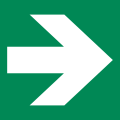 This way (supplementary information sign)
This way (supplementary information sign)
-
 This way (supplementary information sign)
This way (supplementary information sign)
-
 First-aid post
First-aid post
-
 Stretcher
Stretcher
-
 Safety shower
Safety shower
-
 Eyewash
Eyewash
-
 Emergency telephone for first-aid or escape
Emergency telephone for first-aid or escape
Fire-fighting signs
-
 Fire hose
Fire hose
-
 Ladder
Ladder
-
 Fire extinguisher
Fire extinguisher
-
 Emergency fire telephone
Emergency fire telephone
-
 This way (supplementary information sign)
This way (supplementary information sign)
-
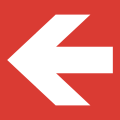 This way (supplementary information sign)
This way (supplementary information sign)
-
 This way (supplementary information sign)
This way (supplementary information sign)
-
 This way (supplementary information sign)
This way (supplementary information sign)
Annex III
Annex III, Minimum Requirements Governing Signs on Containers and Pipes', lays out specific requirements for labeling of piping systems and storage containers containing dangerous substances defined by Directives 67/548 and 88/379.
Annex IV
Annex IV, Minimum Requirements for the identification and location of fire-fighting equipment, is specific to fire-fighting equipment, specifying that red should be used to mark the equipment and its storage location, to supplement the fire-fighting signage provided in Annex III.
Annex V

Annex V, Minimum Requirements Governing Signs Used For Obstacles and Dangerous Locations, and Marking Traffic Routes, lays out the use of colored stripes for marking obstacles and identifying of traffic routes in work places.
Annex VI
Annex VI, Minimum Requirements for Illuminated Signs, sets standards for the use of illuminated signage, the incorporation of colors and pictograms, as defined in Annex I and II and usage with acoustic signals.
Annex VII
Annex VII, Minimum requirements for Acoustic Signs, sets requirements for sound signals, such as horns, sirens, alarm bells.
Annex VIII
Annex VIII, Minimum requirements for Verbal Communication, sets requirements for communications using words, and defines specific code words.
| Code word | Meaning |
|---|---|
| Start | To indicate the start of a command |
| Stop | To interrupt or end a movement |
| End | To stop the operation |
| Raise | To have a load raised |
| Lower | To have a load lowered |
| Forwards | To be coordinated with the corresponding hand signals |
| Backwards | |
| Right | |
| Left | |
| Danger | For an emergency stop |
| Quickly | To speed up a movement for safety reasons |
Annex IX
Annex IX, Minimum Requirements for Hand Signals, describes specific hand signals and the requirements of a "signalman", the person giving the hand signs.
Implementation in member states
European member states adopted the directive in the following legal acts in their nation.
- Austria: Kennzeichnungsverordnung
- Belgium: Arrêté royal du 17 juin 1997
- Bulgaria: РД-07/8 от 20 декември 2008 г.
- Croatia: NN 29/2005
- Cyprus: Σημανσης Ασφαλειας Και Υγειας Στους Χωρους Εργασιας 2012
- Czechia: Č 11/2002 Sb. (Replaced by Č 375/2017 Sb. )
- Denmark: BEK nr 1246 af 11/12/2009
- Estonia: Vastu võetud 30.11.1999 nr 75 Ohumärguannete kasutamise nõuded töökohas
- Finland: Nr. 687/2015
- France: Arrêté du 4 novembre 1993 relatif à la signalisation de sécurité et de santé au travail
- Germany: Arbeitsstättenverordnung, specified by Technische Regel für Arbeitsstätten ASR A1.3
- Greece: Π.Δ. 105/1995
- Hungary: 2/1998. (I. 16.) MüM rendelet a munkahelyen alkalmazandó biztonsági és egészségvédelmi jelzésekről
- Ireland: Safety, Health and Welfare At Work (Signs) Regulations, 1995
- Italy: Decreto Legislativo 14 agosto 1996, n. 493, replaced by Decreto Legislativo 9 aprile 2008, n. 81
- Latvia: Rīgā 2002.gada 3.septembrī prot. Nr.37 17.§
- Lithuania: 1999 m. lapkričio 24 d. Nr. 95 Vilnius
- Malta: S.L.424.16 2002
- Netherlands: Arbeidsomstandighedenregeling
- Portugal: Portaria n.º 1456-A 1995, de 11 de dezembro
- Romania: Hotararea de Guvern 971 din 2006
- Slovakia:Z.z. 387/2006
- Slovenia:Uradni list RS, št. 34/10
- Spain: Real Decreto n° 485/97
- Sweden: AFS 2008-13 (Replaced by AFS 2020-1)
Similar implementations in non-member states
- Iceland: Stjtíð. B, nr. 707/1995
- India: IS 9457 2005 (A copy of the preceding standard 77/576/EEC was also active in India as IS 9457 1980)
- Northern Cyprus: 35/2008 Sayılı Yasa
- Finland: Forskrift 6. oktober 1994 nr. 972
- Ukraine: Кабінету Міністрів України постанова від 25 листопада 2009 р. N 1262 Київ Кабінету Міністрів України постанова від 25 листопада 2009 р. N 1262 Київ
- Turkey: Resmi Gazete Tarihi: 25325/2003
- United Kingdom: The Health and Safety (Safety Signs and Signals) Regulations 1996 (Passed when an EU member, no longer a member.) The LAW and Sign Standard is still in force and in-accordance with the EU (2024)
See also
References
- ^ "Council Directive 92/58/EEC of 24 June 1992 on the minimum requirements for the provision of safety and/or health signs at work (ninth individual Directive within the meaning of Article 16 (1) of Directive 89/391/EEC)". Official Journal of the European Communities. 35: 23–42. 26 August 1992. Retrieved 22 August 2023.
- Non-binding guidelines regarding Directive 92/58/EEC : safety and/or health signs at work (European Commission, Directorate-General for Employment, Social Affairs and Inclusion ed.). Luxembourg: Publications Office of the European Union. November 2022. ISBN 978-92-76-43370-5. Retrieved 22 August 2023.
- "Directive 2014/27/EU of the European Parliament and of the Council of 26 February 2014 amending Council Directives 92/58/EEC, 92/85/EEC, 94/33/EC, 98/24/EC and Directive 2004/37/EC of the European Parliament and of the Council, in order to align them to Regulation (EC) No 1272/2008 on classification, labelling and packaging of substances and mixtures". Official Journal of the European Union. 57: 1–7. 5 March 2014. Retrieved 22 August 2023.
(a) warning sign 'Harmful or irritant material' is deleted.
- Republic of Austria (11 April 1997). "Kennzeichnungsverordnung" (PDF). ris.bka.gv.at (in German). Archived from the original (PDF) on 6 March 2023. Retrieved 1 September 2023.
- "Arrêté royal du 17 juin 1997" (PDF).
- "РД-07/8 от 20 декември 2008 г" (PDF).
- "NN 29/2005".
- "Σημανσης Ασφαλειας Και Υγειας Στους Χωρους Εργασιας 2012" (PDF).
- "Č 11/2002 Sb".
- "Č 375/2017 Sb".
- "BEK nr 1246 af 11/12/2009".
- "Vastu võetud 30.11.1999 nr 75" (PDF).
- "687/2015".
- Légifrance (19 January 2014). "Arrêté du 4 novembre 1993 relatif à la signalisation de sécurité et de santé au travail". legifrance.gouv.fr (in French). French government. Retrieved 1 September 2023.
- "Verordnung über Arbeitsstätten". gesetze-im-internet.de. Retrieved 1 September 2023.
- "ASR A1.3 Sicherheits- und Gesundheitsschutzkennzeichnung". Bundesanstalt für Arbeitsschutz und Arbeitsmedizin. 2022. Retrieved 1 September 2023.
- "Π.Δ. 105/1995" (PDF).
- Magyar Közlöny (2 ed.). Budapest, Hungary: Government of Hungary. 1998-01-16. pp. 174–192. Retrieved 29 October 2023.
- Government of Ireland (1995). "S.I. No. 132/1995 - Safety, Health and Welfare At Work (Signs) Regulations, 1995". irishstatutebook.ie. Government of Ireland. Archived from the original on 1 September 2023. Retrieved 1 September 2023.
- "DECRETO LEGISLATIVO 14 agosto 1996, n. 493 - Attuazione della direttiva 92/58/CEE concernente le prescrizioni minime per la segnaletica di sicurezza e/o di salute sul luogo di lavoro". normattiva.it. 14 August 1996. Retrieved 29 October 2023.
- "DECRETO LEGISLATIVO 9 aprile 2008, n. 81 - Attuazione dell'articolo 1 della legge 3 agosto 2007, n. 123, in materia di tutela della salute e della sicurezza nei luoghi di lavoro". normattiva.it. 9 April 2008. Retrieved 29 October 2023.
- "Rīgā 2002.gada 3.septembrī prot. Nr.37 17.§".
- "1999 m. lapkričio 24 d. Nr. 95 Vilnius".
- "S.L.424.16 2002".
- "Arbeidsomstandighedenregeling".
- "Portaria n.º 1456-A 1995, de 11 de dezembro" (PDF).
- "Hotararea de Guvern 971 din 2006".
- "Real Decreto 485/1997, de 14 de abril, sobre disposiciones mínimas en materia de señalización de seguridad y salud en el trabajo". boe.es. 14 April 1997. Retrieved 29 October 2023.
- "The Health and Safety (Safety Signs and Signals) Regulations 1996". legislation.gov.uk. 1996. Retrieved 29 August 2023.
External links
 Media related to Council Directive Safety Signs - 1992 at Wikimedia Commons
Media related to Council Directive Safety Signs - 1992 at Wikimedia Commons- EUR-Lex - List of National Laws implementing 92/58/EEC


